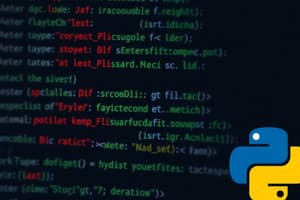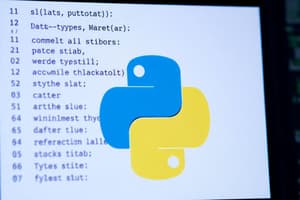Podcast
Questions and Answers
Which of the following code snippets will correctly add 1 to a user-provided number representing the quantity of items?
Which of the following code snippets will correctly add 1 to a user-provided number representing the quantity of items?
- `quantity = input("Enter quantity:")` `new_quantity = quantity + 1` `print(new_quantity)`
- `quantity = str(input("Enter quantity:"))` `new_quantity = quantity + 1` `print(new_quantity)`
- `quantity = int(input("Enter quantity:"))` `new_quantity = quantity + 1` `print(new_quantity)` (correct)
- `quantity = float(input("Enter quantity:"))` `new_quantity = quantity + 1` `print(new_quantity)`
What is the primary reason for converting user input from a string to an integer when performing mathematical operations in Python?
What is the primary reason for converting user input from a string to an integer when performing mathematical operations in Python?
- Strings require more memory than integers, so conversion optimizes performance.
- Mathematical operations are not defined for strings; conversion is necessary for calculations. (correct)
- Strings cannot be printed to the console without conversion.
- Python automatically performs mathematical operations on strings without conversion.
Consider the following code:
age = input("Enter your age: ")
next_year = age + 1
print(next_year)
If the user enters '25', what will be the output, and why?
Consider the following code:
age = input("Enter your age: ")
next_year = age + 1
print(next_year)
If the user enters '25', what will be the output, and why?
- An error, because you can't add a string and an integer.
- An error, because the input needs to be converted.
- 251, because the `+` operator concatenates the string '25' with the integer 1. (correct)
- 26, because the input is automatically converted to an integer.
Which of the following scenarios demonstrates the importance of converting input to the correct data type?
Which of the following scenarios demonstrates the importance of converting input to the correct data type?
Given the code:
x = input("Enter a number: ")
y = x * 2
print(y)
If a user inputs '3', what is the output and the reason for that output?
Given the code:
x = input("Enter a number: ")
y = x * 2
print(y)
If a user inputs '3', what is the output and the reason for that output?
What would be the result of the following Python code snippet?
value = "7.2"
result = int(value)
print(result)
What would be the result of the following Python code snippet?
value = "7.2"
result = int(value)
print(result)
Given the following code, what will final_value be?
initial_value = 15.99
intermediate_value = int(initial_value)
final_value = str(intermediate_value)
Given the following code, what will final_value be?
initial_value = 15.99
intermediate_value = int(initial_value)
final_value = str(intermediate_value)
What is the correct way to convert the float 8.5 into a string?
What is the correct way to convert the float 8.5 into a string?
Consider the following code:
number_str = "10"
number_float = 3.14
result = float(number_str) + number_float
print(result)
What will be the value of result?
Consider the following code:
number_str = "10"
number_float = 3.14
result = float(number_str) + number_float
print(result)
What will be the value of result?
What would be the final data type of the variable data in the following code?
data = 7
data = float(data)
data = str(data)
What would be the final data type of the variable data in the following code?
data = 7
data = float(data)
data = str(data)
If x = 5.7, what will be the output of print(int(x))?
If x = 5.7, what will be the output of print(int(x))?
If you have a variable age = "25", how would you convert it to an integer and add 5 to it?
If you have a variable age = "25", how would you convert it to an integer and add 5 to it?
What will be the data type of variable z after executing the following code?
x = 10
y = "20"
z = str(x) + y
What will be the data type of variable z after executing the following code?
x = 10
y = "20"
z = str(x) + y
Flashcards
What is converting?
What is converting?
Changing a variable's data type.
How to convert to an Integer?
How to convert to an Integer?
Use the int() function.
How does Python convert Float to Integer?
How does Python convert Float to Integer?
It drops the decimal and following numbers. (e.g., 2.8 becomes 2)
How to convert to a String?
How to convert to a String?
Signup and view all the flashcards
How to convert to a Float?
How to convert to a Float?
Signup and view all the flashcards
Why convert '23' from string to integer?
Why convert '23' from string to integer?
Signup and view all the flashcards
What would '23' * 4 print?
What would '23' * 4 print?
Signup and view all the flashcards
What will print(cheese) show? cheese = int('3')
What will print(cheese) show? cheese = int('3')
Signup and view all the flashcards
Input data type
Input data type
Signup and view all the flashcards
Converting input to integer
Converting input to integer
Signup and view all the flashcards
String + Integer = Error
String + Integer = Error
Signup and view all the flashcards
Direct Integer Input
Direct Integer Input
Signup and view all the flashcards
Why convert input?
Why convert input?
Signup and view all the flashcards
Study Notes
- At times, you have to ensure a variable is a specific data type.
- "23" denotes a string
- 23 denotes an integer
- 23.0 denotes a float
Converting to an Integer
- Use the
int()function to convert variables to an integer. - Example:
cheese = "3"
cheese = int("3")
print(cheese) # Output: 3
- You can convert floats to integers, the decimal and any numbers that follow are dropped
- Example:
peppers = 2.8
peppers = int(2.8)
print(peppers) # Output: 2
- Converting a float to an integer does not round down, the decimal is dropped
Converting to a String
- Use the
str()function to convert variables to a string. - Example:
fries = 30
fries = str(30)
print(fries) # Output: "30"
Converting to a Float
- Use the
float()function to convert variables to a float. - Example:
pizza = 4
pizza = float(4)
print(pizza) # Output: 4.0
Converting Inputs
- Inputs are automatically accepted as a string.
- To perform math operations on an input, convert it to an integer first.
- Example of how to convert an input to an integer:
family = int(input("How many family members do you have?"))
baby = family + 1
print(baby)
Studying That Suits You
Use AI to generate personalized quizzes and flashcards to suit your learning preferences.




